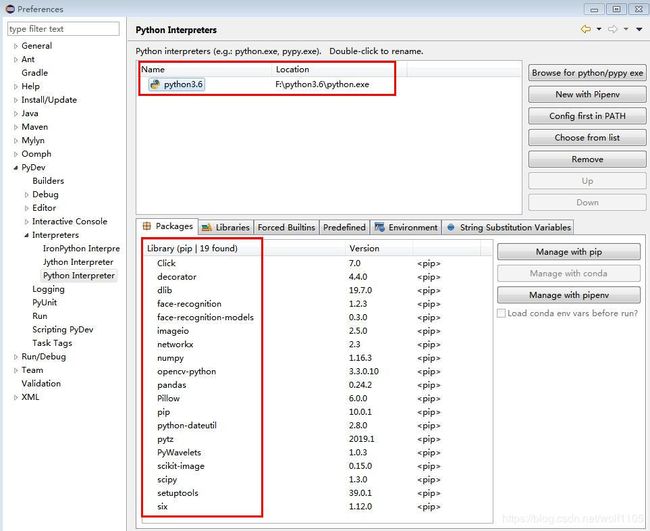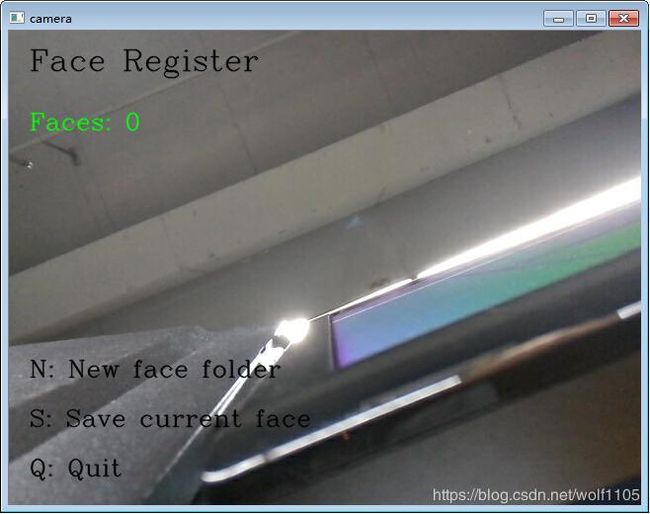Python利用Dlib实现人脸检测和识别
引言
利用 Python 开发,借助 Dlib 库捕获摄像头中的人脸,提取人脸特征,通过计算特征值之间的欧氏距离,来和预存的人脸特征进行对比,判断是否匹配,达到人脸识别的目的;
可以从摄像头中抠取人脸图片存储到本地,然后提取构建预设人脸特征;根据抠取的已有的同一个人多张人脸图片提取 128D 特征值,然后计算该人的 128D 特征均值;
然后和摄像头中实时获取到的人脸提取出的特征值,计算欧氏距离,判定是否为同一张人脸;
系统架构
Windows7: Python3.6 + OpenCv + Dlib ;
1、Dlib的安装(此处是难点,不需安装VS2015)
安装环境:
win7
python3.6 (必须3.6)
第一步:dlib安装:
通过链接:https://pypi.org/simple/dlib/ 下载“dlib-19.7.0-cp36-cp36m-win_amd64.whl“安装包
使用命令:pip install dlib-19.7.0-cp36-cp36m-win_amd64.whl.whl
第二步:face_recognition安装
使用命令:pip install face_recognition
第三步:下载dlib的dat文件
下载地址 http://dlib.net/files/

主要python代码
1、get_faces_from_camera.py / 人脸注册录入
代码如下:
#coding=utf-8
# Updated at 2019-06-04
import dlib # 人脸处理的库 Dlib
import numpy as np # 数据处理的库 Numpy
import cv2 # 图像处理的库 OpenCv
import os # 读写文件
import shutil # 读写文件
# Dlib 正向人脸检测器 / frontal face detector
detector = dlib.get_frontal_face_detector()
# Dlib 68 点特征预测器 / 68 points features predictor
predictor = dlib.shape_predictor('E://DY/Face_AI/data/dlib/shape_predictor_68_face_landmarks.dat')
# OpenCv 调用摄像头 use camera
cap = cv2.VideoCapture(0)
# 设置视频参数 set camera
cap.set(3, 480)
# 人脸截图的计数器 the counter for screen shoot
cnt_ss = 0
# 存储人脸的文件夹 the folder to save faces
current_face_dir = ""
# 保存 faces images 的路径 the directory to save images of faces
path_photos_from_camera = "E://DY/Face_AI/data/data_faces_from_camera/"
# 新建保存人脸图像文件和数据CSV文件夹
# mkdir for saving photos and csv
def pre_work_mkdir():
# 新建文件夹 / make folders to save faces images and csv
if os.path.isdir(path_photos_from_camera):
pass
else:
os.mkdir(path_photos_from_camera)
pre_work_mkdir()
##### optional/可选, 默认关闭 #####
# 删除之前存的人脸数据文件夹
# delete the old data of faces
def pre_work_del_old_face_folders():
# 删除之前存的人脸数据文件夹
# 删除 "/data_faces_from_camera/person_x/"...
folders_rd = os.listdir(path_photos_from_camera)
for i in range(len(folders_rd)):
shutil.rmtree(path_photos_from_camera+folders_rd[i])
if os.path.isfile("data/features_all.csv"):
os.remove("data/features_all.csv")
# 这里在每次程序录入之前, 删掉之前存的人脸数据
# 如果这里打开,每次进行人脸录入的时候都会删掉之前的人脸图像文件夹 person_1/,person_2/,person_3/...
# If enable this function, it will delete all the old data in dir person_1/,person_2/,/person_3/...
# pre_work_del_old_face_folders()
##################################
# 如果有之前录入的人脸 / if the old folders exists
# 在之前 person_x 的序号按照 person_x+1 开始录入 / start from person_x+1
if os.listdir("E://DY/Face_AI/data/data_faces_from_camera/"):
# 获取已录入的最后一个人脸序号 / get the num of latest person
person_list = os.listdir("E://DY/Face_AI/data/data_faces_from_camera/")
person_num_list = []
for person in person_list:
person_num_list.append(int(person.split('_')[-1]))
person_cnt = max(person_num_list)
# 如果第一次存储或者没有之前录入的人脸, 按照 person_1 开始录入
# start from person_1
else:
person_cnt = 0
# 之后用来控制是否保存图像的 flag / the flag to control if save
save_flag = 1
# 之后用来检查是否先按 'n' 再按 's' / the flag to check if press 'n' before 's'
press_n_flag = 0
while cap.isOpened():
flag, img_rd = cap.read()
# print(img_rd.shape)
# It should be 480 height * 640 width
kk = cv2.waitKey(1)
img_gray = cv2.cvtColor(img_rd, cv2.COLOR_RGB2GRAY)
# 人脸数 faces
faces = detector(img_gray, 0)
# 待会要写的字体 / font to write
font = cv2.FONT_HERSHEY_COMPLEX
# 按下 'n' 新建存储人脸的文件夹 / press 'n' to create the folders for saving faces
if kk == ord('n'):
person_cnt += 1
current_face_dir = path_photos_from_camera + "person_" + str(person_cnt)
os.makedirs(current_face_dir)
print('\n')
print("新建的人脸文件夹 / Create folders: ", current_face_dir)
cnt_ss = 0 # 将人脸计数器清零 / clear the cnt of faces
press_n_flag = 1 # 已经按下 'n' / have pressed 'n'
# 检测到人脸 / if face detected
if len(faces) != 0:
# 矩形框 / show the rectangle box
for k, d in enumerate(faces):
# 计算矩形大小
# we need to compute the width and height of the box
# (x,y), (宽度width, 高度height)
pos_start = tuple([d.left(), d.top()])
pos_end = tuple([d.right(), d.bottom()])
# 计算矩形框大小 / compute the size of rectangle box
height = (d.bottom() - d.top())
width = (d.right() - d.left())
hh = int(height/2)
ww = int(width/2)
# 设置颜色 / the color of rectangle of faces detected
color_rectangle = (255, 255, 255)
# 判断人脸矩形框是否超出 480x640
if (d.right()+ww) > 640 or (d.bottom()+hh > 480) or (d.left()-ww < 0) or (d.top()-hh < 0):
cv2.putText(img_rd, "OUT OF RANGE", (20, 300), font, 0.8, (0, 0, 255), 1, cv2.LINE_AA)
color_rectangle = (0, 0, 255)
save_flag = 0
if kk == ord('s'):
print("请调整位置 / Please adjust your position")
else:
color_rectangle = (255, 255, 255)
save_flag = 1
cv2.rectangle(img_rd,
tuple([d.left() - ww, d.top() - hh]),
tuple([d.right() + ww, d.bottom() + hh]),
color_rectangle, 2)
# 根据人脸大小生成空的图像 / create blank image according to the size of face detected
im_blank = np.zeros((int(height*2), width*2, 3), np.uint8)
if save_flag:
# 按下 's' 保存摄像头中的人脸到本地 / press 's' to save faces into local images
if kk == ord('s'):
# 检查有没有先按'n'新建文件夹 / check if you have pressed 'n'
if press_n_flag:
cnt_ss += 1
for ii in range(height*2):
for jj in range(width*2):
im_blank[ii][jj] = img_rd[d.top()-hh + ii][d.left()-ww + jj]
cv2.imwrite(current_face_dir + "/img_face_" + str(cnt_ss) + ".jpg", im_blank)
print("写入本地 / Save into:", str(current_face_dir) + "/img_face_" + str(cnt_ss) + ".jpg")
else:
print("请在按 'S' 之前先按 'N' 来建文件夹 / Please press 'N' before 'S'")
# 显示人脸数 / show the numbers of faces detected
cv2.putText(img_rd, "Faces: " + str(len(faces)), (20, 100), font, 0.8, (0, 255, 0), 1, cv2.LINE_AA)
# 添加说明 / add some statements
cv2.putText(img_rd, "Face Register", (20, 40), font, 1, (0, 0, 0), 1, cv2.LINE_AA)
cv2.putText(img_rd, "N: New face folder", (20, 350), font, 0.8, (0, 0, 0), 1, cv2.LINE_AA)
cv2.putText(img_rd, "S: Save current face", (20, 400), font, 0.8, (0, 0, 0), 1, cv2.LINE_AA)
cv2.putText(img_rd, "Q: Quit", (20, 450), font, 0.8, (0, 0, 0), 1, cv2.LINE_AA)
# 按下 'q' 键退出 / press 'q' to exit
if kk == ord('q'):
break
# 如果需要摄像头窗口大小可调 / uncomment this line if you want the camera window is resizeable
# cv2.namedWindow("camera", 0)
cv2.imshow("camera", img_rd)
# 释放摄像头 / release camera
cap.release()
cv2.destroyAllWindows()
2、features_extraction_to_csv.py 将图像文件中人脸数据提取出来存入CSV
这部分代码实现的功能是将之前捕获到的人脸图像文件,提取出128D特征,然后计算出某人人脸数据的特征均值存入 CSV 中,方便之后识别时候进行比对。
代码如下:
#coding=utf-8
import cv2
import os
import dlib
from skimage import io #pip安装scipy
import csv
import numpy as np
path_images_from_camera = "E://DY/Face_AI/data/data_faces_from_camera/"
detector = dlib.get_frontal_face_detector()
predictor = dlib.shape_predictor("E://DY/Face_AI/data/dlib/shape_predictor_5_face_landmarks.dat")
face_rec = dlib.face_recognition_model_v1("E://DY/Face_AI/data/dlib/dlib_face_recognition_resnet_model_v1.dat")
def return_128d_features(path_img):
img_rd = io.imread(path_img)
img_gray = cv2.cvtColor(img_rd, cv2.COLOR_BGR2RGB)
faces = detector(img_gray, 1)
print("%-40s %-20s" % ("检测到人脸的图像 / image with faces detected:", path_img), '\n')
# 因为有可能截下来的人脸再去检测,检测不出来人脸了
# 所以要确保是 检测到人脸的人脸图像 拿去算特征
if len(faces) != 0:
shape = predictor(img_gray, faces[0])
face_descriptor = face_rec.compute_face_descriptor(img_gray, shape)
else:
face_descriptor = 0
print("no face")
return face_descriptor
def return_features_mean_personX(path_faces_personX):
features_list_personX = []
photos_list = os.listdir(path_faces_personX)
if photos_list:
for i in range(len(photos_list)):
# 调用return_128d_features()得到128d特征
print("%-40s %-20s" % ("正在读的人脸图像 / image to read:", path_faces_personX + "/" + photos_list[i]))
features_128d = return_128d_features(path_faces_personX + "/" + photos_list[i])
# print(features_128d)
# 遇到没有检测出人脸的图片跳过
if features_128d == 0:
i += 1
else:
features_list_personX.append(features_128d)
else:
print("文件夹内图像文件为空 / Warning: No images in " + path_faces_personX + '/', '\n')
# 计算 128D 特征的均值
# personX 的 N 张图像 x 128D -> 1 x 128D
if features_list_personX:
features_mean_personX = np.array(features_list_personX).mean(axis=0)
else:
features_mean_personX = '0'
return features_mean_personX
person_list = os.listdir("E://DY/Face_AI/data/data_faces_from_camera/")
person_num_list = []
for person in person_list:
person_num_list.append(int(person.split('_')[-1]))
person_cnt = max(person_num_list)
with open("E://DY/Face_AI/data/features_all.csv", "w", newline="") as csvfile:
writer = csv.writer(csvfile)
for person in range(person_cnt):
# Get the mean/average features of face/personX, it will be a list with a length of 128D
print(path_images_from_camera + "person_"+str(person+1))
features_mean_personX = return_features_mean_personX(path_images_from_camera + "person_"+str(person+1))
writer.writerow(features_mean_personX)
print("特征均值 / The mean of features:", list(features_mean_personX))
print('\n')
print("所有录入人脸数据存入 / Save all the features of faces registered into: data/features_all.csv")
运行结果如下:

3、face_reco_from_camera.py 实时人脸识别对比分析
功能:调用摄像头,捕获摄像头中的人脸,如果检测到人脸,将摄像头中的人脸提取出128D 的特征,然后和之前录入人脸的128D 特征进行计算欧式距离,如果小于设定值(本文设定为0.4),可以判定为一个人,否则不是。
代码如下:
#coding=utf-8
import dlib # 人脸处理的库 Dlib
import numpy as np # 数据处理的库 numpy
import cv2 # 图像处理的库 OpenCv
import pandas as pd # 数据处理的库 Pandas
facerec = dlib.face_recognition_model_v1("E://DY/Face_AI/data/dlib/dlib_face_recognition_resnet_model_v1.dat")
def return_euclidean_distance(feature_1, feature_2):
feature_1 = np.array(feature_1)
feature_2 = np.array(feature_2)
dist = np.sqrt(np.sum(np.square(feature_1 - feature_2)))
return dist
path_features_known_csv = "E://DY/Face_AI/data/features_all.csv"
csv_rd = pd.read_csv(path_features_known_csv, header=None, error_bad_lines=False)
features_known_arr = []
for i in range(csv_rd.shape[0]):
features_someone_arr = []
for j in range(0, len(csv_rd.ix[i, :])):
features_someone_arr.append(csv_rd.ix[i, :][j])
features_known_arr.append(features_someone_arr)
print("Faces in Database:", len(features_known_arr))
detector = dlib.get_frontal_face_detector()
predictor = dlib.shape_predictor('E://DY/Face_AI/data/dlib/shape_predictor_68_face_landmarks.dat')
cap = cv2.VideoCapture(0)
cap.set(3, 480)
while cap.isOpened():
flag, img_rd = cap.read()
kk = cv2.waitKey(1)
# 取灰度
img_gray = cv2.cvtColor(img_rd, cv2.COLOR_RGB2GRAY)
# 人脸数 faces
faces = detector(img_gray, 0)
# 待会要写的字体 font to write later
font = cv2.FONT_HERSHEY_COMPLEX
# 存储当前摄像头中捕获到的所有人脸的坐标/名字
# the list to save the positions and names of current faces captured
pos_namelist = []
name_namelist = []
# 按下 q 键退出
# press 'q' to exit
if kk == ord('q'):
break
else:
# 检测到人脸 when face detected
if len(faces) != 0:
# 获取当前捕获到的图像的所有人脸的特征,存储到 features_cap_arr
# get the features captured and save into features_cap_arr
features_cap_arr = []
for i in range(len(faces)):
shape = predictor(img_rd, faces[i])
features_cap_arr.append(facerec.compute_face_descriptor(img_rd, shape))
# 遍历捕获到的图像中所有的人脸
# traversal all the faces in the database
for k in range(len(faces)):
print("##### camera person", k+1, "#####")
# 让人名跟随在矩形框的下方
# 确定人名的位置坐标
# 先默认所有人不认识,是 unknown
# set the default names of faces with "unknown"
name_namelist.append("unknown")
# 每个捕获人脸的名字坐标 the positions of faces captured
pos_namelist.append(tuple([faces[k].left(), int(faces[k].bottom() + (faces[k].bottom() - faces[k].top())/4)]))
# 对于某张人脸,遍历所有存储的人脸特征
# for every faces detected, compare the faces in the database
e_distance_list = []
for i in range(len(features_known_arr)):
# 如果 person_X 数据不为空
if str(features_known_arr[i][0]) != '0.0':
print("with person", str(i + 1), "the e distance: ", end='')
e_distance_tmp = return_euclidean_distance(features_cap_arr[k], features_known_arr[i])
print(e_distance_tmp)
e_distance_list.append(e_distance_tmp)
else:
# 空数据 person_X
e_distance_list.append(999999999)
# Find the one with minimum e distance
similar_person_num = e_distance_list.index(min(e_distance_list))
print("Minimum e distance with person", int(similar_person_num)+1)
if min(e_distance_list) < 0.4:
# 在这里修改 person_1, person_2 ... 的名字
# 可以在这里改称 Jack, Tom and others
# Here you can modify the names shown on the camera
name_namelist[k] = "Person "+str(int(similar_person_num)+1)
print("May be person "+str(int(similar_person_num)+1))
else:
print("Unknown person")
# 矩形框
# draw rectangle
for kk, d in enumerate(faces):
# 绘制矩形框
cv2.rectangle(img_rd, tuple([d.left(), d.top()]), tuple([d.right(), d.bottom()]), (0, 255, 255), 2)
print('\n')
# 在人脸框下面写人脸名字
# write names under rectangle
for i in range(len(faces)):
cv2.putText(img_rd, name_namelist[i], pos_namelist[i], font, 0.8, (0, 255, 255), 1, cv2.LINE_AA)
print("Faces in camera now:", name_namelist, "\n")
cv2.putText(img_rd, "Press 'q': Quit", (20, 450), font, 0.8, (84, 255, 159), 1, cv2.LINE_AA)
cv2.putText(img_rd, "Face Recognition", (20, 40), font, 1, (0, 0, 0), 1, cv2.LINE_AA)
cv2.putText(img_rd, "Faces: " + str(len(faces)), (20, 100), font, 1, (0, 0, 255), 1, cv2.LINE_AA)
# 窗口显示 show with opencv
cv2.imshow("camera", img_rd)
cap.release()
cv2.destroyAllWindows()
运行log如下:
##### camera person 1 #####
with person 1 the e distance: 0.3633946712891996
Minimum e distance with person 1
May be person 1
##### camera person 1 ###
with person 1 the e distance: 0.26431970935682836
Minimum e distance with person 1
May be person 1
Faces in camera now: ['Person 1']
Faces in camera now: []
Faces in camera now: []
参考资料:
GitHub : https://github.com/coneypo/Dlib_face_recognition_from_camera

